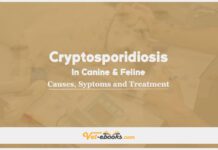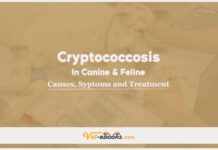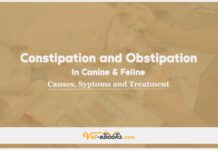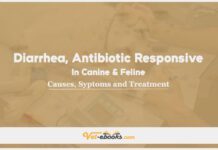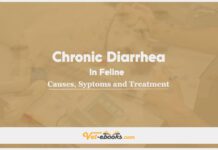Abscessation In Canine and Feline: Causes, Symptoms and Treatment
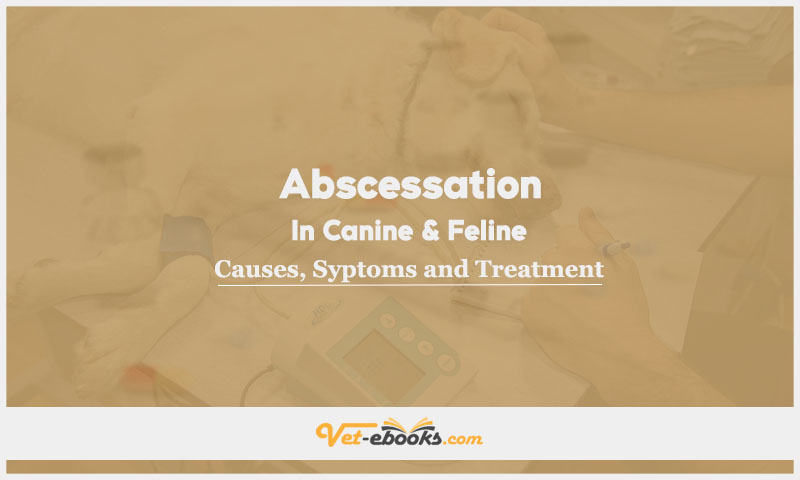
Contents
hide
Overview
An abscess refers to concentrated accumulation of pus enclosed within a restricted tissue area or cavity.
Causes of Abscessation In Canine and Feline
Causes
- Foreign objects.
- Pyogenic bacteria such as Staphylococcus spp., Escherichia coli, β-hemolytic Streptococcus spp., Pseudomonas, Mycoplasma, and Mycoplasma-like organisms (l-forms), Pasteurella multocida, Corynebacterium, Actinomyces spp., Nocardia, Bartonella.
- Obligate anaerobes like Bacteroides spp., Clostridium spp., Peptostreptococcus, Fusobacterium.
- Noninfectious causes like pancreatitis, reactions to sutures, vaccination, administration of other injectable drugs, stings from insects, snake envenomation, immune-mediated panniculitis, dermatitis, neoplasia (especially when the blood supply outgrows).
Risk factors:
- Anal sac-related issues like impaction and anal sacculitis.
- Brain-related conditions such as inner ear inflammation (otitis interna), sinusitis, and oral infections.
- Liver problems like omphalophlebitis and sepsis.
- Lung issues, including foreign object inhalation or migration and bacterial pneumonia.
- Mammary gland complications like mastitis.
- Periorbital concerns like dental disease and the chewing of wood or other plant material.
- Percutaneous factors such as injuries from fights, trauma, or surgical procedures.
- Prostate gland issues like bacterial prostatitis.
- Immunocompromised states caused by feline leukemia virus (FeLV) or feline immunodeficiency virus (FIV) infections, immunosuppressive chemotherapy, acquired or inherited immune system disorders, or underlying predisposing diseases like diabetes mellitus, chronic renal failure, and hyperadrenocorticism.
Pathogenesis of Abscessation In Canine and Feline
- Bacterial organisms can enter tissues through various means, such as penetrating injuries, spreading from another source of infection (through the bloodstream or nearby infected tissues), or the movement of a contaminated object (like a plant awn).
- Typically, bacteria get introduced under the skin through puncture wounds or bites.
- When bacteria or foreign objects remain in the tissue, pus accumulates.
- If this pus is not promptly absorbed or drained, a fibrous capsule forms to isolate the infection, and eventually, the abscess may rupture.
- When a fibrous capsule is present, the cavity needs to fill with granulation tissue for healing, and in some cases, the causative agent may not be completely eliminated. This situation can result in a chronic or intermittent discharge of pus from a draining tract.
- Sterile abscesses can develop when irritants (such as injectable medications or venom) or inflammatory processes (like pancreatitis, immune-mediated reactions, or reduced blood supply) cause the local buildup of pus-like exudate.
Symptoms (History & Physical Examination) of Abscessation In Canine and Feline
History
- Commonly observed non-specific symptoms such as lethargy and loss of appetite.
- A history indicating prior trauma or infection.
- The sudden emergence of painful swelling, either with or without discharge, when the affected area is visible.
Physical Examination
- Determined by the organ system and/or tissue involved.
- Linked to a blend of inflammatory responses, including pain, swelling, redness, warmth, and reduced function.
- tissue destruction, and/or organ system dysfunction caused by accumulation of exudates.
Diagnosis of Abscessation In Canine and Feline
1- From History and Physical Examination
2- Diagnostic Procedures
Fine-Needle Aspiration:
- Aspiration of fluid can yield red, white, yellow, or greenish liquid.
- Protein content exceeding 2.5–3.0 g/dL.
- Nucleated cell count ranges from 3,000 to 100,000 cells/μL or even higher, consisting mainly of degenerate neutrophils, with fewer macrophages and lymphocytes.
- Bacteria present, both inside and outside cells:
- Gram stain used to identify the organism for initial treatment.
- If the causative agent isn’t easily identified with a Romanowsky-type stain, an acid-fast stain is used to detect mycobacteria or Nocardia, and periodic acid-Schiff stain is employed to identify fungus.
Biopsy:
- The biopsy sample should encompass both normal and abnormal tissue.
- Impression smears are taken.
- Tissue is collected for histopathological examination and culture.
- Biopsy is essential for confirming nodular panniculitis.
Culture and Susceptibility Testing:
- Affected tissue and/or exudate are cultured for aerobic and anaerobic bacteria, as well as fungi.
- Blood and/or urine samples are cultured if systemic disease is suspected.
Pathologic Findings:
- The mass lesion contains exudate and is accompanied by inflammation.
- The causative agent may be identifiable.
Urinalysis, Biochemistry, and CBC:
- Complete Blood Count (CBC): Normal; in cases of severe infections, degenerative left shift, neutropenia, and neutrophilia with or without a left shift.
- Serum chemical profile: Varies according to the system impacted and the degree of severity. symptoms such as hyperglycemia if diabetes mellitus is involved, cholestasis if a pancreatic abscess causes blockage, etc.
- Urinalysis: Presence of pus in the urine (pyuria) in cases of prostatic abscess.
Additional Lab Examinations:
- FeLV and FIV testing: Advised for cats with slow-healing or recurring abscesses.
- Cerebrospinal fluid evaluation: Increased cell count and protein levels if a brain abscess is suspected.
- Adrenal function: Assessed for hyperadrenocorticism.
Imaging:
- Radiography: Reveals a soft-tissue density mass in the affected area and may show foreign material.
- Ultrasonography: Helps determine if the mass is fluid-filled, may reveal foreign objects, and echogenic (reflective) fluid suggests purulent exudate.
- Echocardiography: Useful for detecting pericardial abscess and endocarditis.
- CT or MRI: Recommended for suspected pulmonary or brain abscesses.
3- Differential Diagnosis
Differential Diagnosis for Mass Lesions:
- Cyst: Temporary discomfort, slower growth, no apparent signs of inflammation.
- Fibrous scar tissue: Firm and non-painful.
- Granuloma: Less painful, slower growth, firmer texture without a fluctuant center.
- Hematoma/seroma: Variable pain, not encapsulated, initially grows rapidly but slows down once it reaches its full size, initially feels fluctuant but may become firmer over time.
- Neoplasia: Varying growth rates and degrees of pain.
Differential Diagnosis for Draining Tracts:
- Fungal infections: Blastomycosis, coccidioidomycosis, cryptococcosis, histoplasmosis, sporotrichosis.
- Mycobacterial disease.
- Mycetoma: Botryomycosis, actinomycotic mycetoma, eumycotic mycetoma.
- Neoplasia.
- Phaeohyphomycosis.
Treatment of Abscessation In Canine and Feline
General
- Ensure and maintain adequate drainage.
- Surgical removal of the source of infection or foreign objects if necessary.
- Start the right antimicrobial treatment.
- Maintain proper drainage and adhere to antimicrobial therapy for the recommended duration.
- Outpatient care is suitable for minor abscesses, localized infections, and nodular panniculitis.
- Inpatient care is necessary for sepsis, systemic inflammation, extensive surgical procedures, or treatments that demand hospitalization.
- No specific dietary considerations are required.
- Nursing care depends on the abscess’s location.
- Apply warm compresses to the inflamed area when needed.
- Use protective bandages or an Elizabethan collar as required.
- For accumulated exudate, surgical drainage and removal of necrotic tissue may be needed.
- For conditions like sepsis, peritonitis, or pyothorax, fluid therapy, antimicrobial therapy, and intensive care are essential.
- Restrict activity until the abscess has resolved and adequate healing has taken place.
- Ensure appropriate debridement and drainage; sometimes, it may be necessary to leave the wound open to the external surface or place a drain.
- Penrose drains should exit ventrally to facilitate drainage, and they may be bandaged if the bandage is regularly changed.
- If ventral drainage is not feasible, use active drains such as the Jackson-Pratt drain.
- Early drainage is crucial to prevent further tissue damage and the formation of an abscess wall.
- Remove foreign objects, necrotic tissue, and the source of infection.
- Discuss potential complications, including progressive tissue damage, necrosis, wound dehiscence, and prolonged healing times in high-motion areas like the axillary and inguinal regions.
Medications:
- Use antimicrobial drugs effective against the infectious agent and capable of penetrating the infection site.
- Initially, employ broad-spectrum agents with bactericidal properties against both aerobic and anaerobic organisms until culture and sensitivity results are available. Gram stain findings from the exudate can guide therapy.
- For dogs and cats: Options include amoxicillin, amoxicillin–clavulanic acid, clindamycin, and trimethoprim–sulfadiazine.
- Amoxicillin (22 mg/kg PO every 12 hours); amoxicillin-clavulanic acid (22 mg/kg PO every 12 hours). clindamycin (5–10 mg/kg PO every 12 hours);Trimethoprim– sulfadiazine (5–10 mg/kg PO every 12 hours).
- For cats only, pradofloxacin may be considered. pradofloxacin (7.5 mg/kg).
- For cats with Mycoplasma and L-forms, doxycycline is an option.
- In cases of sepsis, peritonitis, or pyothorax, aggressive IV antimicrobial therapy is recommended.
- Sterile abscesses do not require antimicrobial treatment.
Veterinary Books Suggestions
Some Notes:
- The outcome depends on the cause, the organ system involved, and the extent of tissue damage.
- To prevent percutaneous abscesses, take steps to avoid fights among animals, and consider castration to reduce roaming or aggressive behavior.
- For anal sac abscesses, prevention involves avoiding impaction, and for recurrent cases, anal saculectomy may be considered.
- Prostatic abscesses can be prevented by considering castration.
- Prevent mastitis by avoiding lactation, which can be achieved through spaying.
- To prevent periorbital abscesses, ensure that animals do not chew on foreign objects.
Tip
Do You Want To Increase Your Veterinary Knowledge and Practical Skills?
You Can Now Browse and Download +3000 Books For Veterinary Professionals & Students Online.
Download Veterinary Books

